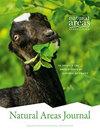Changes in White-Tailed Deer Browsing Selection of Hardwood Tree Species with Increasing Stem Height
IF 0.8
4区 环境科学与生态学
Q4 ECOLOGY
引用次数: 0
Abstract
ABSTRACT To forage optimally, deer select individual plants highest in limiting nutrients, while avoiding individuals that are high in anti-herbivore defenses. For some woody species, deer may selectively browse on larger stems, which can provide a larger amount of younger, more nutritious tissue per individual. However, in some species, larger stems may possess increased levels of anti-herbivore defenses, ultimately discouraging deer from browsing on these larger individuals. We examined differences in the proportion of twigs and stems (individual seedlings/saplings/trees) browsed across three height classes for four species: blue ash (Fraxinus quadrangulata Michx,), white ash (F. americana L.), sassafras (Sassafras albidium Nutt.), and sugar maple (Acer saccharum L.), across multiple sites in central Indiana. Overall, we found that taller stems had a higher likelihood of being browsed, but smaller stems were browsed more heavily. We also found that sugar maple twigs and stems were most likely to be browsed, while sassafras twigs and white ash twigs and stems were least likely to be browsed. Our results indicate that under intense browsing pressure, preference should be given to smaller stems for protection, and that stands with greater vertical stratification of palatable species are more resilient to the effects of deer browsing.白尾鹿对阔叶树树种的取食选择随茎高的变化
为了优化觅食,鹿选择营养限制最高的植物个体,同时避开抗食草动物防御能力高的个体。对于一些木本物种,鹿可能会选择性地啃食较大的茎,这可以为每个个体提供更多的年轻、更有营养的组织。然而,在某些物种中,较大的茎可能具有更高的抗食草动物防御水平,最终使鹿不愿以这些较大的个体为食。在印第安纳州中部的多个地点,我们研究了蓝灰(Fraxinus quadrangulata Michx)、白灰(F. americana L.)、檫树(sassafras albidium Nutt.)和糖枫(Acer saccharum L.)四种树种在三个高度类别上的枝条和茎(单个幼苗/树苗/树)浏览比例的差异。总的来说,我们发现较高的茎有更高的可能性被浏览,但较小的茎被浏览的次数更多。我们还发现糖枫的树枝和茎是最容易被浏览的,而黄樟和白蜡树的树枝和茎是最不容易被浏览的。研究结果表明,在强烈的浏览压力下,应优先考虑较小的茎部进行保护,并且美味物种垂直分层程度较高的林分对鹿的浏览影响更具弹性。
本文章由计算机程序翻译,如有差异,请以英文原文为准。
求助全文
约1分钟内获得全文
求助全文
来源期刊

Natural Areas Journal
环境科学-林学
CiteScore
1.70
自引率
11.10%
发文量
50
审稿时长
>36 weeks
期刊介绍:
The Natural Areas Journal is the flagship publication of the Natural Areas Association is the leading voice in natural areas management and preservation.
The Journal features peer-reviewed original research articles on topics such as:
-Applied conservation biology-
Ecological restoration-
Natural areas management-
Ecological assessment and monitoring-
Invasive and exotic species management-
Habitat protection-
Fire ecology.
It also includes writing on conservation issues, forums, topic reviews, editorials, state and federal natural area activities and book reviews. In addition, we publish special issues on various topics.
 求助内容:
求助内容: 应助结果提醒方式:
应助结果提醒方式:


